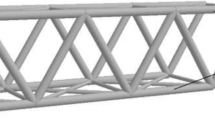Abstract
Concrete filled steel tubes (CFSTs) are composite members that are commonly used in many countries today. CFST components are used in the United States, but they are more common in Asia, in part because the connections used in Asia are quite labor intensive and there are not standard connections in the U.S. In addition, US design specifications are prepared by separate groups for structural steel and reinforced concrete structures and so composite systems that use CFST components are not overseen by a single group and as such there are several conflicting design standards. In the US, steel tubes used for CFST are more slender (i.e., the diameter-to-thickness, D/t, ratio is larger) than some other countries, and labor practices (structural steel labor is different than reinforcing steel labor) also cause potential conflicts in construction. As a result, CFST has had some use in tall building construction in the US, but very limited use in bridge construction. A research program at the University of Washington has been in progress to address many of these issues with an eye towards universal design expressions, simpler, standardized connections and promotion of accelerated bridge construction (ABC). The research has resulted in recent changes to the American Association of State Highway Officials (AASHTO) bridge design specification as well as state departments of transportation (DOTs), which supports the increased use of CFST in bridge piers and pile and drilled-shaft foundations. An experimental research study which included 19 CFST pier-to-footing (or pile-cap) connection tests and 8 CFST pier column-to-precast pier cap tests was performed. These connections provide good performance under both seismic and gravity loads and address the concerns of US construction. These connections, their design rules and requirements, and their impact on composite behavior and system performance are discussed. These results permit rapid and economical construction of CFST bridge piers, piles and drilled shaft foundations. They encourage the use of more slender and economical tubes, while achieving the benefits of composite construction.
Similar content being viewed by others
References
American Association of State Highway and Transportation Officials (AASHTO) (2012) AASHTO LRFD Bridge Design Specifications, Washington, D.C.
American Association of State Highway and Transportation Officials (AASHTO) (2014) AASHTO LRFD Bridge Construction Specifications, 3rd Edition with 2010 through 2014 Interims, Washington, D.C.
American Concrete Institute (ACI) (2011) Building Code Requirements for Structural Concrete (ACI 318-11), Farmington Hills, MI.
American Institute of Steel Construction (AISC) (2010). Specification for Structural Steel Buildings, AISC, Chicago, Illinois.
American Welding Society (AWS) (2010) “Bridge Welding Code,” AASHTO/AWS D1.5:2010 Standard, Miama, FL.
Bishop, E. (2009) Evaluation of the Flexural Resistance and Stiffness Models for Circular Concrete-Filled Steel Tube Members Subjected to Combined Axial-Flexural Loading, a thesis submitted in partial fulfillment of the Master of Science in Civil Engineering Degree, University of Washington, Seattle, December 2009.
Lehman, D.E. and Roeder, C.W. (2012) “Foundation Connection for Circular Concrete Filled Tubes,” Journal of Constructional Steel Research, Vol. 78, November 2012, pp. 212–225, Elsevier.
Lehman, D.E., Kuder, K., Gunnarsson, A.K., Roeder, C.W., and Berman, J.W. (2013) “Circular Concrete Filled Tubes for Improved Sustainability and Seismically Resilience”, Journal of Structural Engineering, ASCE, Reston, VA, ISSN 0733-9445/B4014008(12).
Moon, J., Lehman, D.E., Roeder, C.W., and Lee, H-E (2013) “Evaluation of Embedded Concrete Filled Tube (CFT) Column-to-Foundation Connections,” Engineering Structures, Vol. 56, pp. 22–35, Elsevier.
Moon, J., Lehman, D.E., and Roeder, C.W. (2012) “Strength of Circular Concrete Filled Tubes (CFT) with and without Internal Reinforcement Under Combined Loading,” Journal of Structural Engineering, ASCE, Reston, VA, DOI:10.1061(ASCE)ST1943-541X.000078.
Moon, J., Roeder, C.W., Lehman, D.E., and Lee, H-E (2012) “Analytical Modeling of Bending of Circular Concrete-Filled Tubes,” submitted for publication review, Engineering Structures, Elsevier.
Priestley, M.J., Seible, F., and Xiao, Y. (1994) “Steel jacket retrofitting of RCbridge columns for enhanced shear strength; test results and comparison with theory,” ACI Structural Journal, Vol 91, pp 537–551.
Roeder, C.W., and Lehman, D.E. (2012) “Initial Investigation of RCFilled Tubes for use in Bridge Foundations,” Washington State Dept. of Transportation Report WA-RD 776.1, Olympia, WA.
Roeder, C.W., Lehman, D.E., Stephens, M. (2014) “Concrete Filled Steel Tubes for Accelerated Bridge Construction,” Transportation Research Record No. 2406, Vol. 1, Washington, DC, pp. 49–58.
Roeder, C.W., Lehman, D.E., and Bishop, E. (2010) “Strength and Stiffness of Circular Concrete Filled Tubes,” ASCE, Journal of Structural Engineering, Vol 136, No. 12, pp. 1545–1553, Reston, VA.
Stephens, M. T., Berg, L. M, Lehman, D.E. and Roeder, C.W. (2014) “Circular concrete filled tube bridge pier connections for accelerated bridge construction,” Proceedings: 2014 National Accelerated Bridge Construction Conference, Miami, FL, pp. 354–363.
Stephens, M.T., Lehman, D.E, and Roeder, C.W. (2015). Concrete-Filled Tube Bridge Pier Connections for Accelerated Bridge Construction. Report for the California Department of Transportation. Report Number CA15-2417.
Stephens, M., Berg, L., Lehman, D., and Roeder, C. (2016). “Seismic CFST Column-to-Precast Cap Beam Connections for Accelerated Bridge Construction.” J. Struct. Eng., 10.1061/(ASCE)ST.1943-541X.0001505, 04016049.
Author information
Authors and Affiliations
Corresponding author
Rights and permissions
About this article
Cite this article
Roeder, C.W., Stephens, M.T. & Lehman, D.E. Concrete Filled Steel Tubes for Bridge Pier and Foundation Construction. Int J Steel Struct 18, 39–49 (2018). https://doi.org/10.1007/s13296-018-0304-7
Received:
Accepted:
Published:
Issue Date:
DOI: https://doi.org/10.1007/s13296-018-0304-7




